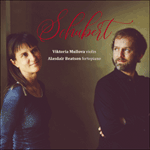
Welcome to Hyperion Records, a British classical label devoted to presenting high-quality recordings of music of all styles and from all periods from the twelfth century to the twenty-first.
Hyperion offers both CDs, and downloads in a number of formats. The site is also available in several languages.
Please use the dropdown buttons to set your preferred options, or use the checkbox to accept the defaults.

| Viktoria Mullova (violin), Alasdair Beatson (fortepiano)» More |
The Presto second movement is an exuberant take on the Beethovenian scherzo, full of teasingly irregular phrases, abrupt changes of dynamics and vertiginous leaps for the violin. In the second half Schubert spirits us to remote tonal regions with nonchalant sleight-of-hand. The C major Andantino begins with one of Schubert’s most guileless tunes. But initial impressions are belied by the music’s harmonic adventure, both in the opening section, which quickly drifts to a far-flung D flat major, and in the central episode. After a condensed reprise of the opening (with the tune underpinned by a little rhythmic figure from the central section), the major-minor equivocation of the very last bars is a touching and characteristic Schubertian effect. Opening with a faint reminiscence of the scherzo, the finale is a movement of irresistible verve that combines the melodic generosity of the first movement with the scherzo’s ebullience and tonal caprice.
from notes by Richard Wigmore © 2013
Le deuxième mouvement Presto est une exubérante prise en charge du scherzo beethovénien, truffée de phrases plaisamment irrégulières, de brusques changements de dynamique et de sauts vertigineux pour le violon. Dans la seconde moitié, Schubert nous entraîne avec une dextérité nonchalante dans des régions tonales éloignées. L’Andantino en ut majeur s’ouvre sur l’un des airs schubertiens les plus ingénus, même si les impressions premières sont démenties par l’audace harmonique de la musique, que ce soit dans la section inaugurale, qui file vers un lointain ré bémol majeur, ou dans l’épisode central. Passée une reprise condensée de l’ouverture (avec la mélodie soutenue par une petite figure rythmique issue de la section centrale), l’équivoque majeur-mineur des toutes dernières mesures est un effet schubertien touchant. Partant sur une pâle réminiscence du scherzo, le finale est un mouvement d’une verve irrésistible où la générosité mélodique du premier mouvement se mêle au bouillonnement et au caprice tonal du scherzo.
extrait des notes rédigées par Richard Wigmore © 2013
Français: Hypérion
Der zweite Satz, Presto, ist eine ausgelassene Version eines Beethoven’schen Scherzos, voller neckisch-ungleichmäßiger Phrasen, abrupter Dynamikwechsel und schwindelerregender Sprünge für die Violine. In der zweiten Hälfte zaubert Schubert uns geschickt in abgelegene tonale Regionen. Das Andantino in C-Dur beginnt mit einer der arglosesten Melodien Schuberts. Doch wird der anfängliche Eindruck bald durch die harmonische Abenteuerlust, sowohl im Eröffnungsteil, der schnell in ein abgelegenes Des-Dur abdriftet, als auch in dem zentralen Abschnitt umgestoßen. Nach einer komprimierten Reprise des Anfangs (wobei die Melodie von einer kleinen rhythmischen Figur aus dem Mittelteil untermauert wird) erscheint die Dur-Moll-Zweideutigkeit der allerletzten Takte als anrührender und charakteristischer Schubert’scher Effekt. Das Finale beginnt mit einer vagen Erinnerung an das Scherzo und ist ein Satz unwiderstehlicher Verve, in dem die melodische Freizügigkeit des ersten Satzes mit der Überschwänglichkeit und tonalen Willkür des Scherzos kombiniert wird.
aus dem Begleittext von Richard Wigmore © 2013
Deutsch: Viola Scheffel
 Schubert: Violin Sonata, Fantasy & Rondo Schubert: Violin Sonata, Fantasy & RondoThree sublime masterworks from the final decade of Schubert's all-too-short life, in performances every bit as ground-breaking as the composer must have intended them to be.» More |

